Hermaea sp. 1
Order: SACOGLOSSA
Superfamily: LIMAPONTIOIDEA
Family: Hermaeidae
DISTRIBUTION
southeastern Australia
See discussion below. Possibly juveniles of Hermaea evelinemarcusae but may be an undescribed species.
Authorship detailsRudman, W.B., 2008 (August 12) Hermaea sp. 1 [In] Sea Slug Forum. Australian Museum, Sydney. Available from http://www.seaslugforum.net/find/hermsp1
Related messages
Re: Hermaea sp. at Woody Point
August 12, 2008
From: Kathe R. Jensen
Concerning message #21775:
Dear David and Bill,
You are raising a couple of questions here: First, is this species Hermaea evelinemarcusae? No, I don't think so. H. evelinemarcusae has sparse lateral branches from the central digestive tubule throughout the length of the cerata (not the "cruciate" pattern at the tip). Also, H. evelinemarcusae was feeding on a species of Griffithsia, tentatively identified as G. ovalis, which has large, bubble-like cells rather than the fine filamentous algae seen on these pictures.
The second question is concerning the esophageal pouch and its function. In some species the muscular esophageal pouch seems to be involved in the process of "buccal regurgitation", during which the sacoglossan regurgitates an amount of cell sap (cytoplasm plus the contents of the central vacuole) back into the algal filament, possibly mixed with saliva. The function of this process could be to make it easier to suck up the remaining cell sap by starting some enzymatic breakdown inside the algal filament, or maybe preventing the "wound-healing" process that many siphonalean algae have. In some sacoglossans, notably the Oxynoidae, the esophageal pouch seems to have a glandular wall rather than a muscular one, but I have no idea what the function of that might be. As far as I remember oxynoids do not have buccal regurgitation.
Best wishes,
Kathe
krjensen@snm.ku.dk
Jensen, K.R., 2008 (Aug 12) Re: Hermaea sp. at Woody Point. [Message in] Sea Slug Forum. Australian Museum, Sydney. Available from http://www.seaslugforum.net/find/21792Thanks Kathe,
I agree that even taking size into account, David's animals look rather different to H. evelinemarcusae. So I'll put them on a separate page as Hermaea sp. 1.
Best wishes,
Bill Rudman
Hermaea sp. at Woody Point [2]
August 11, 2008
From: David Mullins
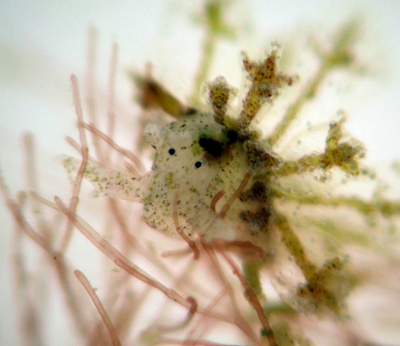
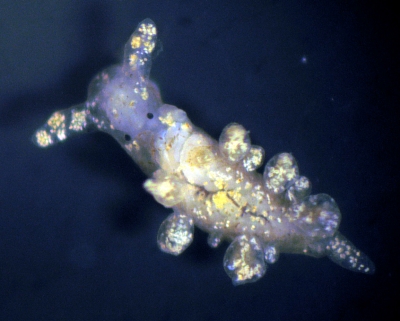
Dear Bill,
Here are some further photos of the Hermaea sp. found recently at Woody Point [see message #21775 ].
They include pics of feeding on the red algae as well as a juvenile 1 mm in length with much smaller cerata.
Locality: Woody Point, Redcliffe Peninsula, Moreton Bay, intertidal, Queensland, Australia., Pacific Ocean, 08 July 2008, Intertidal weed, rocky substrate. Length: 1 to 3 mm. Photographer: David Mullins.
Kind regards,
David Mullins.
marineimages@hotmail.com
Mullins, D.A., 2008 (Aug 11) Hermaea sp. at Woody Point [2]. [Message in] Sea Slug Forum. Australian Museum, Sydney. Available from http://www.seaslugforum.net/find/21776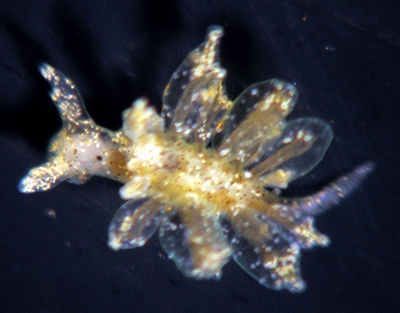
Thanks David,
Excellent photos for something so small.
Best wishes,
Bill Rudman
Hermaea sp. at Woody Point [1]
August 11, 2008
From: David Mullins
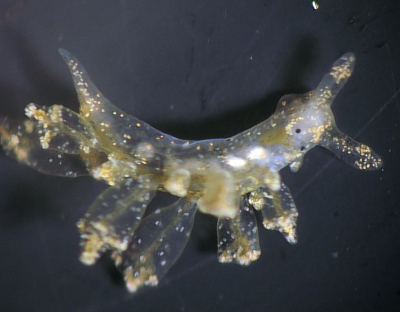
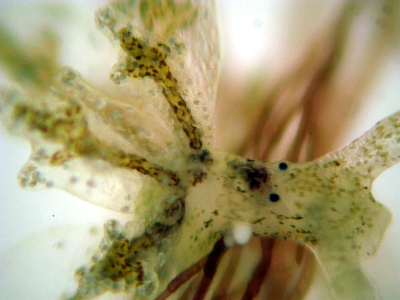
Concerning message #17004:
Dear Bill,
We have found some nice specimens of a Hermaea species here at Woody Point. A "colony" of 4 to 5 were observed feeding on filamentous red algae attached to small rocks lying on the silty sandy substrate of the intertidal zone. Whilst we have nicknamed it "golden nuggets" I have not been able to find a match for it in the records available to me although the general appearance is definitely of Hermaea.
The rhinophores clearly exhibit a step two thirds of the way towards the tip. Although the golden brown diverticula form a distinctive crucifix shape towards the distal end with the cerata swelling at that point I don't believe in other aspects that it could be called a H. cf. cruciata.
I understand that the two small white swellings visible on the right side behind and below the eye are the separate male and female pores with the male to the fore. The body as well as the cerata is basically transparent, except for some colour spots, allowing the full length of the digestive diverticulum and organs to be visible. Could the dark colour patch on the left side at the "neck" behind the eyes be food in the oesophageal diverticulum?
Locality: Woody Point, Redcliffe Peninsula, Moreton Bay, intertidal, Queensland, Australia., Pacific Ocean, 08 July 2008, Intertidal weed, rocky substrate. Length: 1 to 3 mm. Photographer: David Mullins.
Some additional pics follow in a subsequent message [#21776 ].
Kind regards,
David Mullins.
marineimages@hotmail.com
Mullins, D.A., 2008 (Aug 11) Hermaea sp. at Woody Point [1]. [Message in] Sea Slug Forum. Australian Museum, Sydney. Available from http://www.seaslugforum.net/find/21775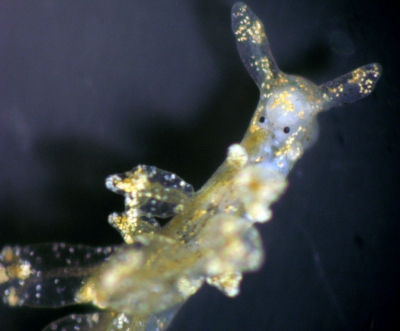
Dear David,
Thanks for these interesting photos. I am not sure if this is the only named species from Australia, H. evelinemarcusi, or not. Bob Burn is of the opinion that there are 3 or 4 species in southeastern Australia and he could be right. I'll place it under that species, more for convenience than from confidence.
Concerning its anatomy, yes the white swelling sare the male [anterior] and female [posterior] openings. You ask if the coloured mass behind the eyes is 'the oesophageal diverticulum'. Many sacoglossans have a blind sac or pouch off the oesophagus. I am not sure from the literature just what its function is but what you are describing is this pouch. You can see it as a pink structure in the lower photo on the Fact Sheet. Although 'diverticulum' means a blind pouch, it's probably best not to call this an 'oesophgeal diverticulum' because many people call the digestive gland the 'digestive diverticulum' so it could lead to confusion as the oesophageal pouch is not part of the digestive gland. Perhaps Kathe Jensen can give us a summary or a reference to the function of the oseophageal pouch in sacoglossans.
Best wishes,
Bill Rudman
